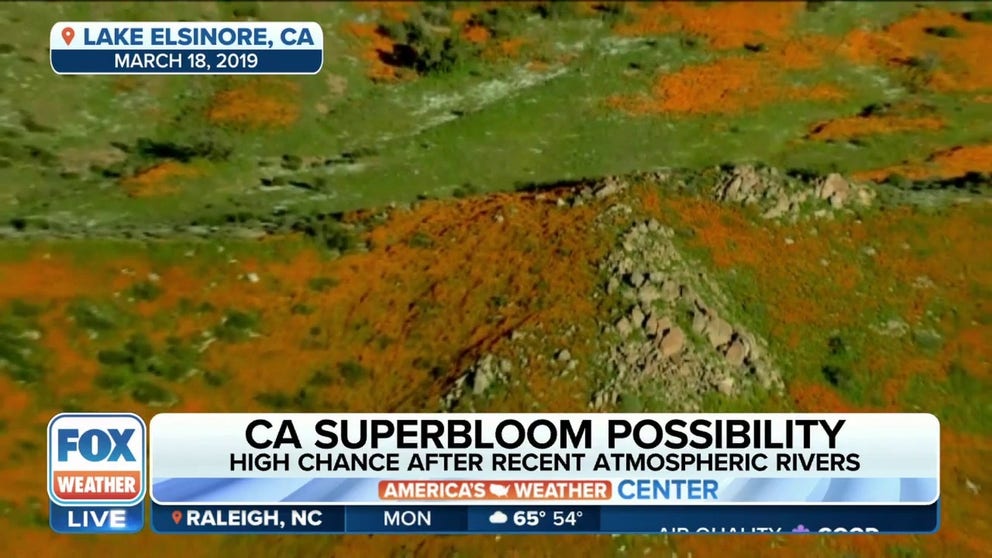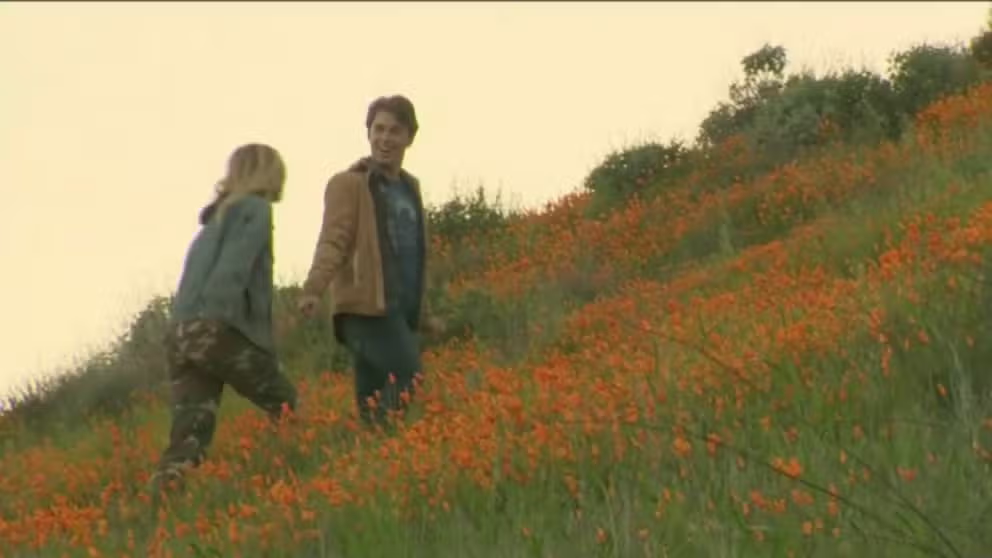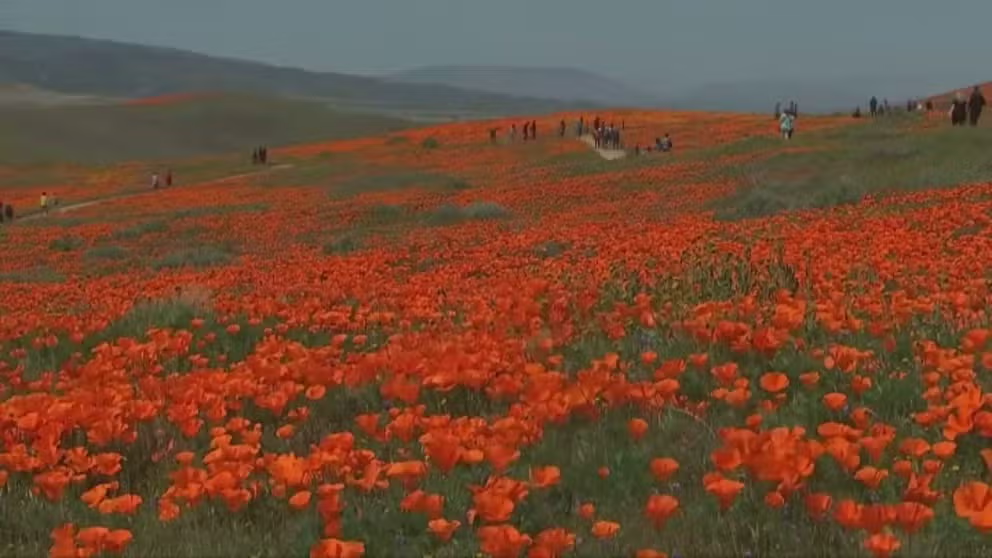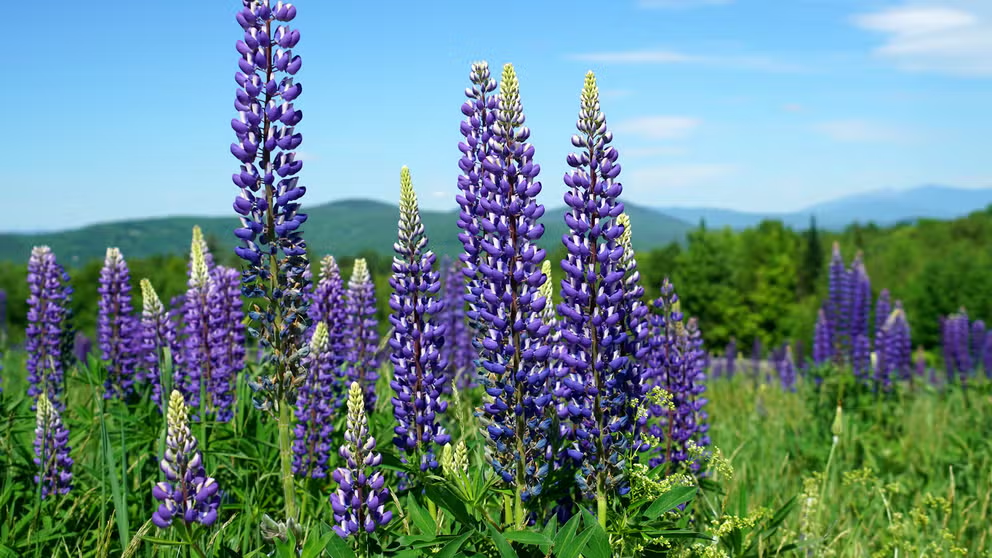Superbloom 2023: Will California see one after continuous atmospheric river storms?
After years of drought, atmospheric river storms finally drenched the desert. The last time that happened was the drought-buster 2017 winter which lead to the 2017 superbloom. Another round of atmospheric river storms hit in 2019, and the desert superbloomed again.
California has high chance to see superbloom after recent atmospheric rivers
Mike McElhatton, Director for Anza-Borrego Desert Natural History Association, says they have experienced more rain this year so it has helped create a spectacular bloom and they are at about 75-80% of bloom already this year.
ANZA-BORREGO DESERT STATE PARK, Calif. – It's expected to be a great bloom in California, but will it be a superbloom? One flower tracker is cautiously optimistic.
"It's hard to predict. And so even now, I think most people, like myself, are saying, ‘Yeah, we expect a really good bloom this year,’" said Mike McElhatton, who tracks the blooms for the Anza-Borrego Desert Natural History Association.
"The fact is, it's already blooming. We do have this pretty unusual winter bloom, with certain areas looking as good as they do during the peak bloom. So that might seem to say, ‘oh, well, it's only going to get better,’ right?" he continued.

Some of the unusual early bloomers in the Anza-Borrego Desert.
(Suzanne Brooks / FOX Weather)
Ingredients for a superbloom
The ingredients are all there, he said about the rain followed by warm temperatures.
"One of the good things is in some of the places where we have these blooms, they seem to be getting thicker," McElhatton said. "So, like sand verbena is a plant that's purple is really pretty across the ground. And it sends out these roots for it to expand, and that's happening. So that looks promising."
7 MOST BEAUTIFUL PLACES TO SEE FLOWERS BLOOM IN THE US
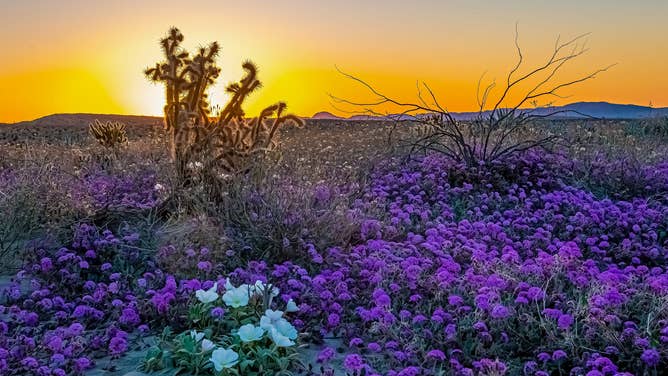
Sand verbena blooms thick across the Anza-Borrego Desert State Park.
(Paulette Donellon / FOX Weather)
The Anza-Borrego Desert is one of the prime viewing superbloom sites in the state. The state park was overrun by tourists in 2017 when McElhatton said bumper-to-bumper traffic stretched for 15 miles, and stores and restaurants ran out of goods on one particular Saturday.
Drought-busting atmospheric river storms drenched the state over the 2016/2017 winter. Another round of super-soaker storms struck again in 2019, which accounted for another superbloom year. Years of drought followed until a parade of atmospheric river storms drowned California this winter.
Superbloom 2019: Could it happen this year?
Wildflowers blanketed the hills in Lake Elsinore, California in March 2019. This was the last superbloom to color California. Could it happen again in 2023 after the parade of atmospheric river storms dropped 32 trillion gallons of water on the state in 3 weeks this winter?
"This weekend was very reminiscent of what I saw during superbloom year, the mountains are literally turning green," part-time resident and photographer Paulette Donellon said and added she is seeing unusual birds too. "I was also very excited going down the trails, seeing a lot of sprouts coming up. So I wouldn't count that as a superbloom. But I think it's going to be pretty brilliant out there for sure."
POLLEN LEVELS CREEP UP AS WINTER'S ARCTIC BLAST BECOMES A DISTANT MEMORY
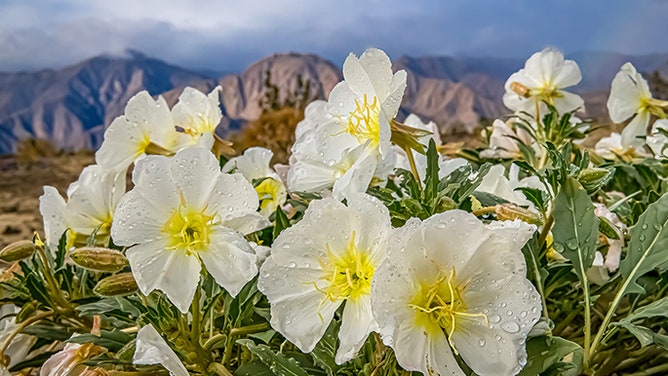
Dune evening primrose near Borrego Springs.
(Paulette Donellon / FOX Weather)
RELENTLESS CALIFORNIA ATMOSPHERIC RIVERS DROP 32 TRILLION GALLONS OF WATER OVER 3 WEEKS
The intense rain and snowmakers dropped 32 trillion gallons of water across the Golden State. Averaged out, that would mean that every square inch of the state received over 11 inches of rain. Roads washed out, mudslides took homes, sinkholes swallowed cars, and flash flooding claimed over a dozen lives.
After so much tragedy and loss, Californians are finally getting a glimpse at the silver lining. Already the state shed the "extreme and exceptional" drought classifications. Only 32% of the state is in "severe drought," which is down from 92% since before the storms. And now, we see desert blooms.
Seeds lay dormant waiting for flooding rains
"A lot of desert plants, the seeds can be in the soil for a very long time before they germinate. And they will just wait there, they can be there for years and then, you know, they'll take off," said McElhatton. "Just around my house, I have all of these palo verde trees that are a foot high. I mean, they're everywhere. And I haven't had those palo verde in my yard or close to here for a long time."
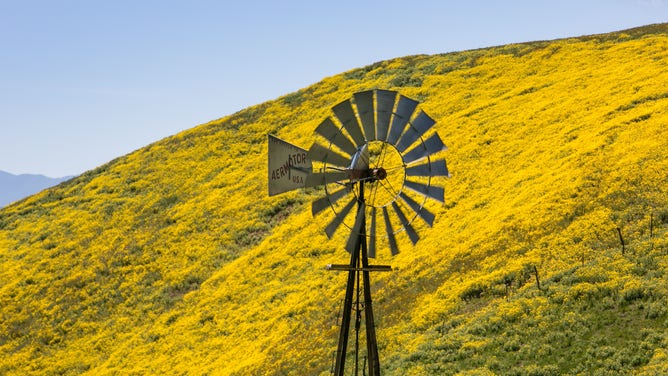
Hillsides and cattle pastures along Highway 58 between Santa Margarita and McKittrick are covered in wildflowers as viewed on March 28, 2017, near Carrizo Plain National Monument, California.
(George Rose / Getty Images)
He said that the blooming flowers drop seeds during the lush and wet years. Those seeds wait for optimal conditions before blooming. Smoke tree seeds need a flood to penetrate the seed coating to sprout.
"It's this adaptation that's built into the plants," he said. "It's like this race to continue into the future. So the flowers grow, and they put in seeds in the ground, and they've adapted so that they can be there for a long time with no water. And then when water comes, it's like, 'Okay, let's get moving here and grow and put out some flowers and put some seeds in the ground so that we can keep this thing going.'"
HOW TO WATCH FOX WEATHER ON TV
2019 Superbloom in Lake Elsinore
This is the 2019 superbloom in Lake Elsinore, California where thousands of visitors a day created a "nightmare" according to FOX 11 Los Angeles. Fields and hills were covered with poppies as far as the eye could see.
The widespread rain is key for flowers to bloom across vistas. Usually, desert rains are torrential but spotty, but not this year. The vast amount of rain falling from atmospheric river storms provided a soaking every couple of days.
"The rain is so localized. Usually, you'll find like one canyon or one wash that maybe just gets dumped on, and there will be some flash floods," he said while other areas stay dry. "We always have flowers in this in the spring, even when there's not a lot of rain. But they're different. If they want to see the fields of flowers, the desert sunflower and the purple verbena… the big bloom, you know, that people call the superbloom."
What could go wrong?
McElhatton still won’t forecast the superbloom.
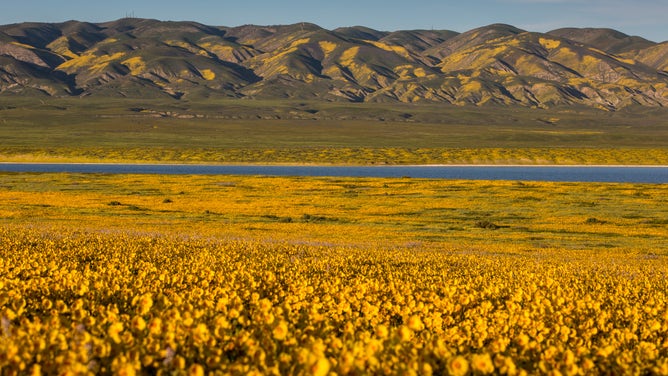
CARRIZO PLAIN NATIONAL MONUMENT, CA - The 2017 superbloom featuring Palo Verde flowers.
( George Rose / Getty Images)
"Everybody who has experienced this before is always a little bit cautious, there are a couple of things that could happen," he hedged. "It's just the very subtle ways that those things get mixed together that will either give you a really good bloom or not."
One of those factors is competition from other plants. The rest of the brush thrives off the same rain and warmth as the wildflowers do and could edge out the colorful species. A few cold days could delay blooming, while a long cold snap could kill the tender blooms.
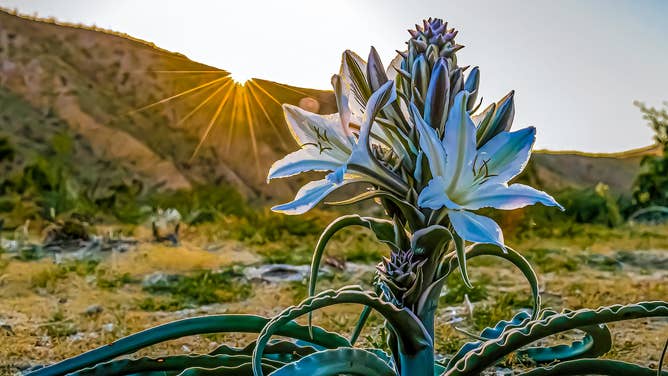
The desert lily in the Anza-Borrego Desert State Park.
(Paulette Donellon / FOX Weather)
And beware of the caterpillars. The warmth also hatches the white-lined sphinx moth caterpillar.
"The caterpillars just devour flowers. I mean, it's like an army that has the command to eat those flowers," McElhatton said. "You'll see where they are, and you'll see acres and acres from one day to the next that are completely depleted."
Visitors are another disastrous factor. FOX 11 Los Angeles reports that Lake Elsinore officials adopted a zero-tolerance policy for trespassers and anyone who parks on the sides of the roads. FOX 11 says this is a reaction to the "poppy nightmare" of 2019, the last superbloom.
WATCH: SATELLITE PHOTOS CAPTURE SNOW ON MARS DESERTS WITH ERIE COMPARISONS TO EARTH
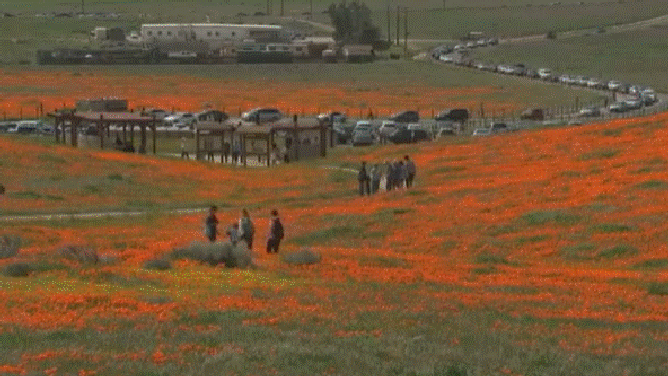
The superbloom in 2019 created the "poppy nightmare" in Lake Elsinore. Thousands of visitors arrived day after day.
(Reuters / FOX Weather)
"It was kind of like out of the movie... the freeway was stopped… people were getting out of their cars and walking the hillsides," officials described the 2019 scene to FOX 11. "The flowers were beautiful, the scene was a nightmare."
The city encourages people to view its live webcam pointed directly at Walker Canyon to see the poppies instead. In 2019, a ranger also said that trampling a flower will kill it before it releases seeds for the next bloom.
Primetime viewing is around the corner
McElhatton said the flowers are not at peak bloom yet. He tracks and posts the floral progress on ABDNHA’s website for anyone looking for a road trip. The association also makes flower maps for the area based on recent visitor’s reports.
He estimates that late February to early March will be a prime time.
7 of the best places to see flower superblooms in the U.S.
With the arrival of spring, fields across the United States come alive with color in stunning floral displays.
